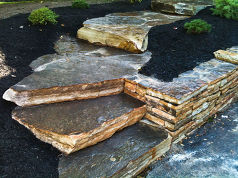Ideas for Stone Walkways

Just like your home, you want your yard to express who you are. You’ve chosen the plants carefully by color and, of course, by their suitability to the climate. Whether you planted them yourself or had a landscaper do it, as you look around now, you can see that it’s time to take the next step – literally. It’s time to install the path that will take you around your beautiful, colorful yard. As you look around, you wonder: what sort of path will set off the color and texture of your yard to best advantage?
As you do with your plants, you’ll want to take several factors into consideration. First of all, what sort of climate do you live in? If you live in an area with extreme cold and heat – or even one of those extremes – you may want to consult a local professional about the most suitable type of material to use. A landscaper in Minneapolis will know to use hard stone such as granite that will not crack during a winter freeze. He will avoid softer stones such as sandstone or limestone, which are better for warmer climates.
There are lots of choices when it comes to building a garden path, but if you’re looking specifically at options in stone, here are some ideas.
Types of Stone Garden Paths
Brick. Here’s where you can get creative. Brick comes in lots of colors, with are lots of patterns to choose from – and you can also create your own pattern. Affordable and durable, brick is safer in cold and wet climates because of its rough surface. (Make sure that you choose paving bricks, not wall bricks, for your project.) You will need to install steel or plastic edging to make sure that the bricks stay in place over time. Otherwise, they may shift or spread.
Gravel or crushed stone. These low-cost, non-slip materials, which provide good drainage for your yard, are easy to install. As with bricks, you’ll need edging, plus you’ll also need to rake the surface every so often to keep it clean.
Stone. While stone is one of the most beautiful surfaces, it is also one of the most expensive and challenging to install. If you decide to go with a stone path, make sure that you have a pro do the job – otherwise, the stone could crack.
Mixed materials. Usually a combination of brick, ceramic and stone, mixed materials give your yard a unique look. Use colors that will set off the plants in your yard – and, of course, safety first: use rough stone for better traction.
Stepping stones. A stepping-stone path can save wear and tear on the grass around it, or the stepping stones may be set in gravel with the added touch of brick edging on either side.
Concrete. Remember that you can also use concrete for this kind of project. Less expensive than stone, concrete comes in a variety of colors and can be molded to any shape or texture. If you should choose concrete for your path, consult a reliable concrete contractor to lay it for you, since this type of work is best left to a professional.
Looking for a Pro? Call us (866) 441-6648

Landscaping Average Costs
Landscapers Experiences

Don’t Be A Goober – Hire Qualified Pros For Safe Tree Removal

Seamless Extension Of Concrete Patio And Poolside Retaining Wall



